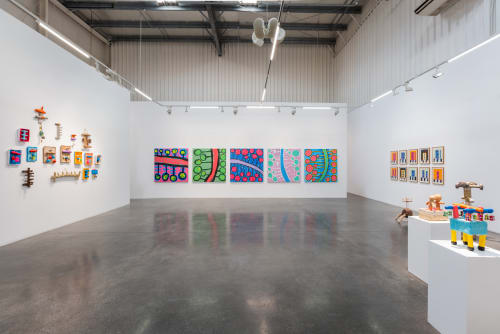Memory Drum is the second solo exhibition of Mohamed Ahmed Ibrahim (b.1962) at the gallery, comprising a series of new paintings and sculptures, produced during his time in isolation in his Khorfakkan studio during the 2020 lockdown.
In psychology, Memory Drum is a theory that unconscious neural patterns acquired from past experience are stored in the central nervous system within a memory storage organ, analogous to the drum used to store music in the old-fashioned roll pianos. It also refers to the “drum memory” of early computers, a magnetic storage device. Ibrahim relates it to the theory of innateness in developmental psychology - that children have an innate knowledge. This innate knowledge for the artist is more important than that learnt later on throughout the course of life. Most people lose touch with it through learned behaviours, but Ibrahim is constantly aware of it, especially so during this time of enforced isolation, which has forced him to go back deeper still into his “drum memory”.
The new paintings, Flowers and Boulevards, are rooted in Ibrahim’s previous semi-figural paintings of symbols. More plant-like than figure-like, both represent growth and are interconnected, yet on different scales. The same forms become either flowers or towering trees, depending upon context: the Flowers paintings are growing from schematic pots, whilst the Boulevards paintings recall aerial maps of cities or landscapes, with large trees lining roads or rivers. Conversely, they may also be read as zoomed-in slides of organic matter viewed under a microscope.
Play is central to Ibrahim’s practice. With much of his three-dimensional work in papier-maché, he may play for weeks with his materials, mixing in leaves, grass, tea, coffee or tobacco into his paper mix to produce nuanced natural and neutral tones. Some of the free-standing sculptures evoke humanoid figures and are named as such - Dancer Contessa, for example. The smaller wall-based sculptures have the feel of children’s toys – either rattles or those that hang over babies’ cribs.
The change in emphasis toward semi-figural, both in painting and in sculpture, is a clear development in Ibrahim’s practice, balanced as it is by tendencies that remain: the repetition of mark-making and forms in the paintings; the automatic almost subconscious object-making of the sculptures, analogous to organic growth; the disregard of scale, and the vibrancy of colour and texture that suffuse both.

